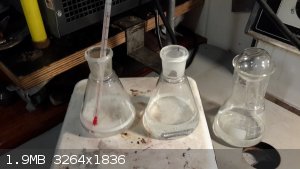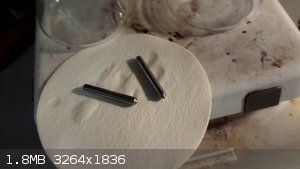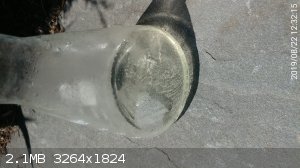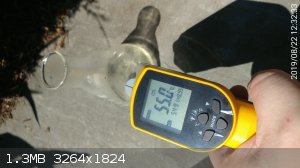| Pages:
1
2
3 |
stamasd
Hazard to Others
  
Posts: 133
Registered: 24-5-2018
Location: in the crosshairs
Member Is Offline
Mood: moody
|
|
Tungsten metal plus piranha solution?
Does anyone have experience with reacting metallic tungsten with piranha solution? My ultimate goal is to make WO3 as easily as possible from metallic
tungsten. I haven't found much about the subject via a web search. The only mention is here https://www.tungsten.com/chemical-resistance-of-tungsten/ : a mix of ammonia and H2O2 (aka "basic piranha") reacts with tungsten "under certain
conditions"
|
|
|
Panache
International Hazard
    
Posts: 1290
Registered: 18-10-2007
Member Is Offline
Mood: Instead of being my deliverance, she had a resemblance to a Kat named Frankenstein
|
|
Good question (cf/ so many questions here....8).
No idea but it seems like something i should try today, give me a few hours, i have all the reagants at hand.
|
|
|
stamasd
Hazard to Others
  
Posts: 133
Registered: 24-5-2018
Location: in the crosshairs
Member Is Offline
Mood: moody
|
|
Thanks for trying it. I have the chemicals too but it's night time here so I won't be able to try until tomorrow.
|
|
|
j_sum1
Administrator
       
Posts: 6218
Registered: 4-10-2014
Location: Unmoved
Member Is Offline
Mood: Organised
|
|
Tungsten will dissolve in H2O2 but it takes time. Think days not hours. I think this is the standard method for making WO3.
I have not done this myself -- a fellow member sent me some WO3 when he was working on this. I have done it with Mo and found there were many
different reactions when I used different acids with the peroxide. I don't think I tried with ammonia however.
|
|
|
Panache
International Hazard
    
Posts: 1290
Registered: 18-10-2007
Member Is Offline
Mood: Instead of being my deliverance, she had a resemblance to a Kat named Frankenstein
|
|
Having never made basic piranha before i sought a reference, before simply using 28% ammonia soln and conc sulphuric in a 3:1 volume ratio.
The mit guide confirmed the ratios, but also that it has to be at 60C or higher foreffective use.
Thus ill try two tungsten dissolutions, one at rt one at 60C.
As a control ill use an incandescent globe to light the room.

|
|
|
stamasd
Hazard to Others
  
Posts: 133
Registered: 24-5-2018
Location: in the crosshairs
Member Is Offline
Mood: moody
|
|
Good luck! Depending on how it goes I'll prepare my own experiment tomorrow.
Also I assume you meant ammonia and H2O2 above. Don't mix concentrated ammonia with sulfuric acid. 
|
|
|
Tsjerk
International Hazard
    
Posts: 3022
Registered: 20-4-2005
Location: Netherlands
Member Is Offline
Mood: Mood
|
|
Tungsten should indeed dissolve in ammonia / peroxide. You don't need much ammonia, it is is used to keep the pH up and to keep tungstic acid in
solution. You can precipitate tungstic acid by acidification.
WO3 can be made from the acid by heating on a flame.
|
|
|
Panache
International Hazard
    
Posts: 1290
Registered: 18-10-2007
Member Is Offline
Mood: Instead of being my deliverance, she had a resemblance to a Kat named Frankenstein
|
|
Its going well, ive intially used some primary gap electrodes as the tungsten source because they are thick, thus should react controllably?
Checkedvyge density 19.3, close enough 
This is the beginning, on the left is the solutio i had heated to 60, one right rt.


|
|
|
stamasd
Hazard to Others
  
Posts: 133
Registered: 24-5-2018
Location: in the crosshairs
Member Is Offline
Mood: moody
|
|
So here's my ongoing experiment. Just started it but so far it's going very well.
2.35g piece of tungsten electrode (TIG)
25ml 29% NH4OH plus 10ml 27% H2O2
Dropped tungsten in, placed outside in the sun on a piece of rock that has been baking in the sun for a few hours. Without any extra heating, just the
heat from the rock and the reaction itself brought the temperature to 55C.
Vigorous reaction, and after 5 minutes the solution has already turned pale yellow from dissolved WO3.
 
[Edited on 22-8-2019 by stamasd]
|
|
|
Tsjerk
International Hazard
    
Posts: 3022
Registered: 20-4-2005
Location: Netherlands
Member Is Offline
Mood: Mood
|
|
Nice work! If it is so vigorous, maybe diluting it down a bit and heating it way less would help against the decomposition of the peroxide and the
vaporizing of the ammonia. My feeling says little ammonia will stay dissolved at 55 degrees. Just take your time with a stoppered flask.
WO3 doesn't dissolve  it is ammium tungstate. You want to keep that in solution,
otherwise it forms paratungstate which is much less soluble. Getting that back in solution is no fun. it is ammium tungstate. You want to keep that in solution,
otherwise it forms paratungstate which is much less soluble. Getting that back in solution is no fun.
When have tungstic acid, you have way more freedom in making WO3 compared to when making it from ammonium paratungstate.
All the more reason to keep it cool and diluted. Ammonium metatungstate is soluble up to about 0,1 g/ml.
|
|
|
stamasd
Hazard to Others
  
Posts: 133
Registered: 24-5-2018
Location: in the crosshairs
Member Is Offline
Mood: moody
|
|
So the latest update: i checked at 1.5h, the bubbling had stopped. The flask was still warm though not as much as before. The place where it rested
was now in the shade. I didn't have the thermometer with me so I don't have the precise temperature. I estimate around 40C. The color was the same
pale yellow, and there was a minute amount of needle-like crystals floating at the surface.
At this point I moved the flask to another warm place and waited for a few minutes to see if the reaction restarts. It did not. It still smelled very
strongly of ammonia, though this in itself can be deceiving as to how much of the NH3 was still present.
Next step, I added another 10ml H2O2. For a few seconds nothing happened, then all of a sudden the whole liquid started bubbling violently and foaming
about half-way up the flask. But since the flask is intentionally much larger than the volumes involved, it was nowhere near to the spilling point.
The bubbling died down in about 10seconds. Completely, no bubbling at all after that. The color also disappeared completely and now it's clear and
colorless like water. No trace of crystals left either. I think all of the extra H2O2 that I added decomposed at once, oxidizing everything it could
in the process.
This is very instructive. I have moved the flask now to a cool place, put a stopper and will allow it to cool to room temperature. Then I will add an
extra portion of H2O2, and possibly extra ammonia as well.
The piece of tungsten looks corroded. Dull gray from the shiny gray it was before.
[Edited on 22-8-2019 by stamasd]
|
|
|
stamasd
Hazard to Others
  
Posts: 133
Registered: 24-5-2018
Location: in the crosshairs
Member Is Offline
Mood: moody
|
|
Next step: after a further 2h in which nothing happened, I added another 10ml H2O2 to the room temperature flask (meaning around 32C).
Immediately the liquid turned pale yellow again, and gas bubbles started evolving from the tungsten. Not violent like the previous time, and localized
on the metal only. That tells me that there's probably still enough ammonia to drive the reaction.
I don't really know how to explain the color changes though.
Continuing to observe.
|
|
|
stamasd
Hazard to Others
  
Posts: 133
Registered: 24-5-2018
Location: in the crosshairs
Member Is Offline
Mood: moody
|
|
So, lesson learned: the "basic" piranha solution can be every bit as violent as the acid one.
This morning I added again to the reaction (at room temperature) 20ml H2O2 and 5ml NH4OH.
It started bubbling around the tungsten, but over the next 2 minutes the bubbling expanded gradually to the whole volume of liquid and foam started
rising. The flask became hot, and eventually overflowed (because the total volume was higher now than yesterday). When I noticed that the temperature
was rising I wuickly moved the flask into a water bath I had ready nearby so the overflow occured in the water bath. I estimate that I lost 5-10ml of
the liquid.
At this point I decided to stop the experiment. There was again almost no gas production at all after the overflow, probably because all of the H2O2
decomposed in bulk.
Total in:
2.35g tungsten
30ml 29%NH4OH
40ml 27%H2O2
Total out:
2.308g tungsten (a whopping 42mg decrease)
50ml reaction mix
The missing volume is due to the overflow and probably some evaporation.
Workup in progress. I neutralized the solution with 20% HCl to slightly acidic pH=5. No precipitate formed. Now I'm evaporating it slowly on low heat.
Notes for the follow-up experiment: probably most of the H2O2 was wasted during the two episodes where it decomposed in bulk. Instead of adding it in
big batches, small and repeated additions would probably be best. A very slow running addition funnel? The problem is, my only addition funnel is way
too big, 250ml. Now I wish I had a 25-50ml one.
[Edited on 23-8-2019 by stamasd]
|
|
|
Tsjerk
International Hazard
    
Posts: 3022
Registered: 20-4-2005
Location: Netherlands
Member Is Offline
Mood: Mood
|
|
Maybe you can try with less ammonia. Sure the basic piranha is nice to wash flasks and fritted funnels, but to dissolve tungsten it only has to be
basic, I would guess around pH 11.
Peroxide is acidic and the higher the pH the more of it is in the -O-O- form. That might be why all your peroxide is
decomposing.
I would try to see what happens when you leave it for a day or two at RT with enough peroxide to lets say dissolve half a gram W, with just enough
ammonia to keep the pH at around 11.
I would also start with a volume that is big enough to dissolve the amount of tungsten calculated to dissolve.
The reaction does consume a bit of OH-, but half a gram of tungsten can never use much.
[Edited on 23-8-2019 by Tsjerk]
|
|
|
stamasd
Hazard to Others
  
Posts: 133
Registered: 24-5-2018
Location: in the crosshairs
Member Is Offline
Mood: moody
|
|
Yes, less ammonia should work. The reaction appears to proceed vigorously enough at RT when enough peroxide is around. The decomposition of which is
what limits its efficiency.
The evaporation of the solution on low heat has produced a white powder, most of which I think is ammonium chloride, perhaps with a small amount of
ammonium tungstate. I will try to calcinate it, but that's for another day. I have house chores to attend to for the rest of the day.
(edit) the weight of the residue is 1.31g. There is also a fine white powder coating the inside of the flask all the way to the top, most likely
evaporated and recrystallized ammonium chloride. I will not try to recover that as it's irrelevant to the main experiment.
Based on the tungsten weight difference, at most 60mg ammonium tungstate should be in that residue. And at most 52mg WO3 should result from
calcination.
[Edited on 23-8-2019 by stamasd]
|
|
|
Tsjerk
International Hazard
    
Posts: 3022
Registered: 20-4-2005
Location: Netherlands
Member Is Offline
Mood: Mood
|
|
If you really wanted to you could put the flask on a flame to get rid of the ammonium chloride.
[Edited on 23-8-2019 by Tsjerk]
|
|
|
wg48temp9
National Hazard
   
Posts: 761
Registered: 30-12-2018
Location: not so United Kingdom
Member Is Offline
|
|
Plain H2O2 is all that's needed. See the note below. Adding alkali will accelerate the decomposition of the peroxide as its less stable in high ph.
"Tungsten wire of common sizes can
be dissolved in 30% hydrogen peroxide
in convenient times (3 hours or less)
at 60” C., the optimum temperature.
Powder, especially of finer sizes, is
best dissolved in more dilute (10%)
reagent at room temperature to decrease
the violence of the reaction.
Most samples of commercially pure
tungsten dissolved completely; however, certain less pure grades gave a
visible residue or turbidity which was
found by qualitative spectrographic
analysis to consist of insoluble oxide or
hydroxide impurities, principally of
Si, with smaller proportions of AI, Ti,
Mg, and Fe. The turbidity was cleared
by the addition of sodium hydroxide.
Tungsten may be converted into
various of its compounds via dissolution in hydrogen peroxide. Evaporation of the solution and drying of the
residue at not over 100” C. produces
yellow crystalline pertungstic acid which
is freely soluble in hot water. Higher
drying temperatures (ca. 180” C. and
higher) convert the pertungstic acid
to tungstic acid, or anhydrous tungsten
trioxide, which may be reacted and
dissolved in accordance with their
known properties. Alternatively, the
alkali tungstates may be produced by
addition of alkali hydroxide to the
pertungstic acid solution, followed by
boiling to expel both the free and combined hydrogen peroxide.
Hydrogen peroxide as a solvent for
tungsten has the advantages over the
commonly employed nitric-hydrofluoric
acid mixture of not requiring platinum
ware, and of not introducing a difficultly removable anion. "
From: Murau, P. C. (1961). Dissolution of Tungsten by Hydrogen Peroxide. Analytical Chemistry, 33(8), 1125–1126. doi:10.1021/ac60176a021
I am wg48 but not on my usual pc hence the temp handle.
Thank goodness for Fleming and the fungi.
Old codger' lives matters, wear a mask and help save them.
Be aware of demagoguery, keep your frontal lobes fully engaged.
I don't know who invented mRNA vaccines but they should get a fancy medal and I hope they made a shed load of money from it.
|
|
|
stamasd
Hazard to Others
  
Posts: 133
Registered: 24-5-2018
Location: in the crosshairs
Member Is Offline
Mood: moody
|
|
See that's the kind of information that I could have used before starting.  ^^ ^^
What I found by myself led me to believe that H2O2 alone, or even with ammonia, wouldn't be active enough.
|
|
|
diddi
National Hazard
   
Posts: 723
Registered: 23-9-2014
Location: Victoria, Australia
Member Is Offline
Mood: Fluorescent
|
|
i see you are using TIG electrodes as your source. i use just 50% H2O2 to dissolve the electrodes, but i collect the Thorium. the W is just a
biproduct for me (but i do keep it). They take weeks to dissolve btw.
Beginning construction of periodic table display
|
|
|
stamasd
Hazard to Others
  
Posts: 133
Registered: 24-5-2018
Location: in the crosshairs
Member Is Offline
Mood: moody
|
|
I don't have access to 50% H2O2, the max I can get is 27%. Yes, TIG electrodes; the one I'm using is 2% lanthanated because I have a lot of scrap
pieces of that (I have thoriated too but no scrap pieces of that and I'd rather not break a good electrode).
I have restarted another experiment last evening with the remaining tungsten piece, 20ml H2O2 and a few drops of ammonia at RT. Haven't checked on it
today yet, but yesterday there was just a little gas generation around the tungsten.
|
|
|
AJKOER
Radically Dubious
    
Posts: 3026
Registered: 7-5-2011
Member Is Offline
Mood: No Mood
|
|
Per this study https://apps.dtic.mil/dtic/tr/fulltext/u2/a358781.pdf Tungsten can be made to corrode, at least to a limited extent, in the presence of 1% aqueous
Na2SO4 (or, apparently better, is NaCl, see https://books.google.com/books?id=Uuz1Qgi3qLwC&pg=PA18&a... ), relative to select alloys (for example, Cu(70%) /Zn(30%) and one alloy
containing a small amount of Carbon), per Table 3.
As such, I would try (pending a cheap available W source, most likely the filament in an incandescent bulb) a galvanic cell approach employing
Tungsten metal (low surface area) versus Carbon (as graphite with more relative surface area) with household H2O2 in an electrolyte of sea salt in a
microwave assisted prep.
------------------------------------------------------------------------------------
Interestingly, came across this health warning sheet on Tungsten at https://www.atsdr.cdc.gov/toxfaqs/tfacts186.pdf .
[Edited on 24-8-2019 by AJKOER]
|
|
|
Tsjerk
International Hazard
    
Posts: 3022
Registered: 20-4-2005
Location: Netherlands
Member Is Offline
Mood: Mood
|
|
Quote: Originally posted by AJKOER  | Per this study https://apps.dtic.mil/dtic/tr/fulltext/u2/a358781.pdf Tungsten can be made to corrode, at least to a limited extent, in the presence of 1% aqueous
Na2SO4 (or, apparently better, is NaCl, see https://books.google.com/books?id=Uuz1Qgi3qLwC&pg=PA18&a... ), relative to select alloys (for example, Cu(70%) /Zn(30%) and one alloy
containing a small amount of Carbon), per Table 3.
As such, I would try (pending a cheap available W source, most likely the filament in an incandescent bulb) a galvanic cell approach employing
Tungsten metal (low surface area) versus Carbon (as graphite with more relative surface area) with household H2O2 in an electrolyte of sea salt in a
microwave assisted prep.
------------------------------------------------------------------------------------
Interestingly, came across this health warning sheet on Tungsten at https://www.atsdr.cdc.gov/toxfaqs/tfacts186.pdf .
[Edited on 24-8-2019 by AJKOER] |
It is perfectly fine for everyone to completely ignore this post as irrelevant and imaginary.
|
|
|
AJKOER
Radically Dubious
    
Posts: 3026
Registered: 7-5-2011
Member Is Offline
Mood: No Mood
|
|
Quote: Originally posted by Tsjerk  | ......
It is perfectly fine for everyone to completely ignore this post as irrelevant and imaginary. |
Perhaps this is a correct assessment, but I have already secured two W filaments, and may be able to soon test my claim.
To be clear, I have to exceed only "to a limited extent".
--------------------------------------------------------------
Another point, working with NH3/O2 or H2O2 is, in my assessment, not a basic piranha reaction, actually electrochemical (and a bit more) in nature.
See related chemistry with copper, ammonia and O2 (or H2O2) at https://www.sciencemadness.org/whisper/viewthread.php?tid=15... and elsewhere on this forum.
Implication of this point is adding NH4Cl (or the sulfate) likely improves the reaction rate as in the case of copper.
I believe this ammonia/H2O2 plus NH4Cl path to be the best path.
---------------------------------------------------------------------------
OK, did a quick run with an electric bulb filament based on a bleach battery (but I acidified NaOCl with NaHCO3 forming HOCl) using a graphite rod as
an electrode.
Unexpected result (much bubbling at the carbon rods in a solution of HOCl, but only after 90 seconds of microwave heating) suggesting that electric
bulbs are tested with a small amount of air presence in the bulb. This implies to me that the W wire actually has an oxide coating, which actually
makes the filament more noble than carbon.
The picture here appears to confirm my thoughts https://en.m.wikipedia.org/wiki/Incandescent_light_bulb and is not the picture of the metal displayed here https://en.m.wikipedia.org/wiki/Tungsten .
Apparently, I will have to find another source of Tungsten metal.
[EDIT] Video of reaction attached below. I will place all other comments and experimental results in a new thread.
[Edited on 25-8-2019 by AJKOER]
|
|
|
AJKOER
Radically Dubious
    
Posts: 3026
Registered: 7-5-2011
Member Is Offline
Mood: No Mood
|
|
Short clip showing, apparently in the presence of tungsten oxide filament, gas bubbles evolving from the carbon rods in HOCl after removal from the
microwave following 3 treatments of 30 seconds (with the prior 30 second intervals indicating no reaction).
Attachment: W_Carbon_Run.mp4 (2.3MB)
This file has been downloaded 492 times
[Edited on 25-8-2019 by AJKOER]
|
|
|
Panache
International Hazard
    
Posts: 1290
Registered: 18-10-2007
Member Is Offline
Mood: Instead of being my deliverance, she had a resemblance to a Kat named Frankenstein
|
|
Apologies for the late sub back into the game...life, other priorities ensued, some observations.
I think the 60C with the ammonia only reduces the extent of the reaction when dealing with tungsten samples of low surfAce are. Of the two I ran (one
at rf one at 60) the one start bubbles continuously, although one would never say vigourously. However it ran (ie 'bubbled off the electrode)far
longer than the hot one and ulitimately dissolved more tungsten by weight.
I'm about work them up by Tserk, thanks for the reference and even with this limited experience it would that it rings true.
|
|
|
| Pages:
1
2
3 |